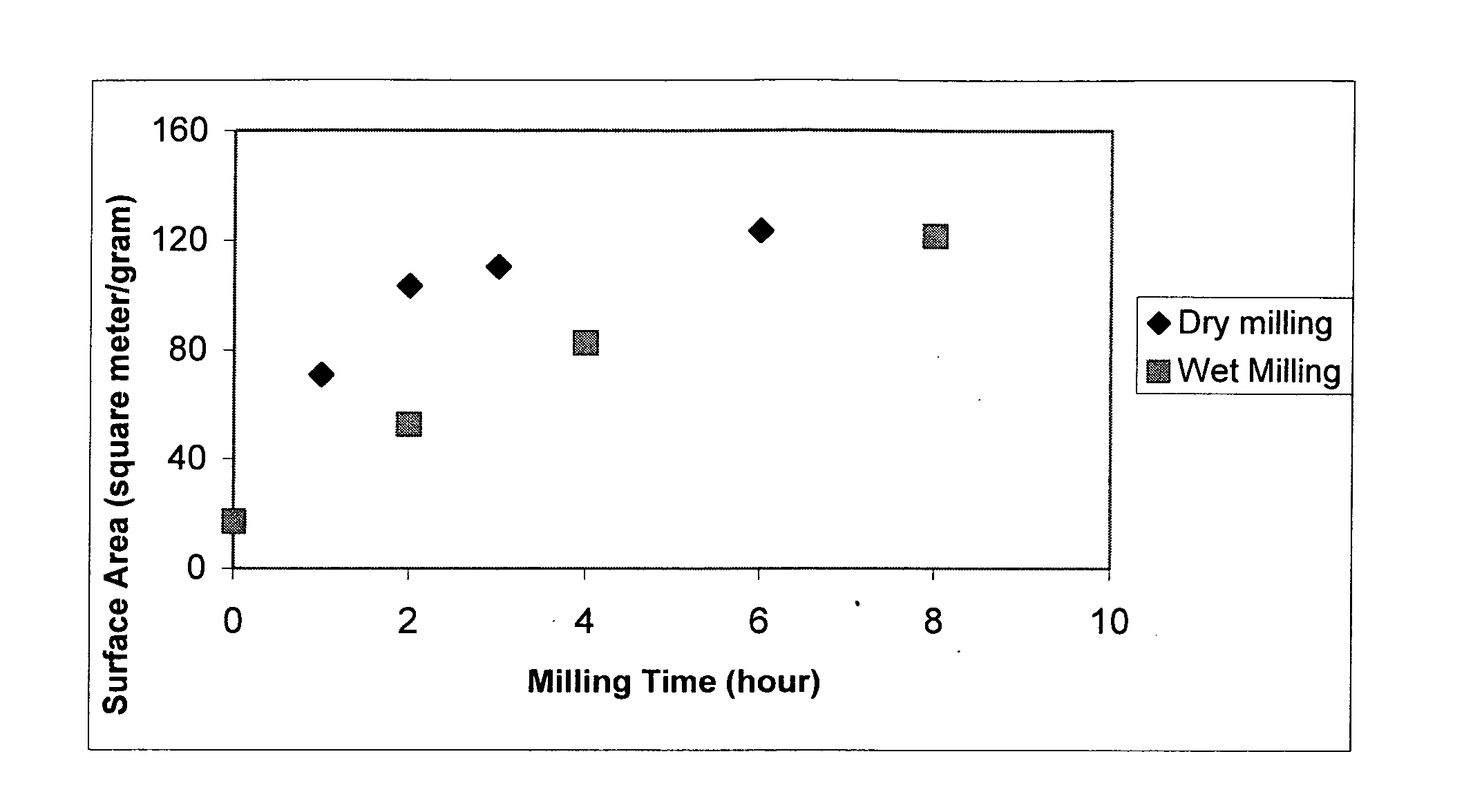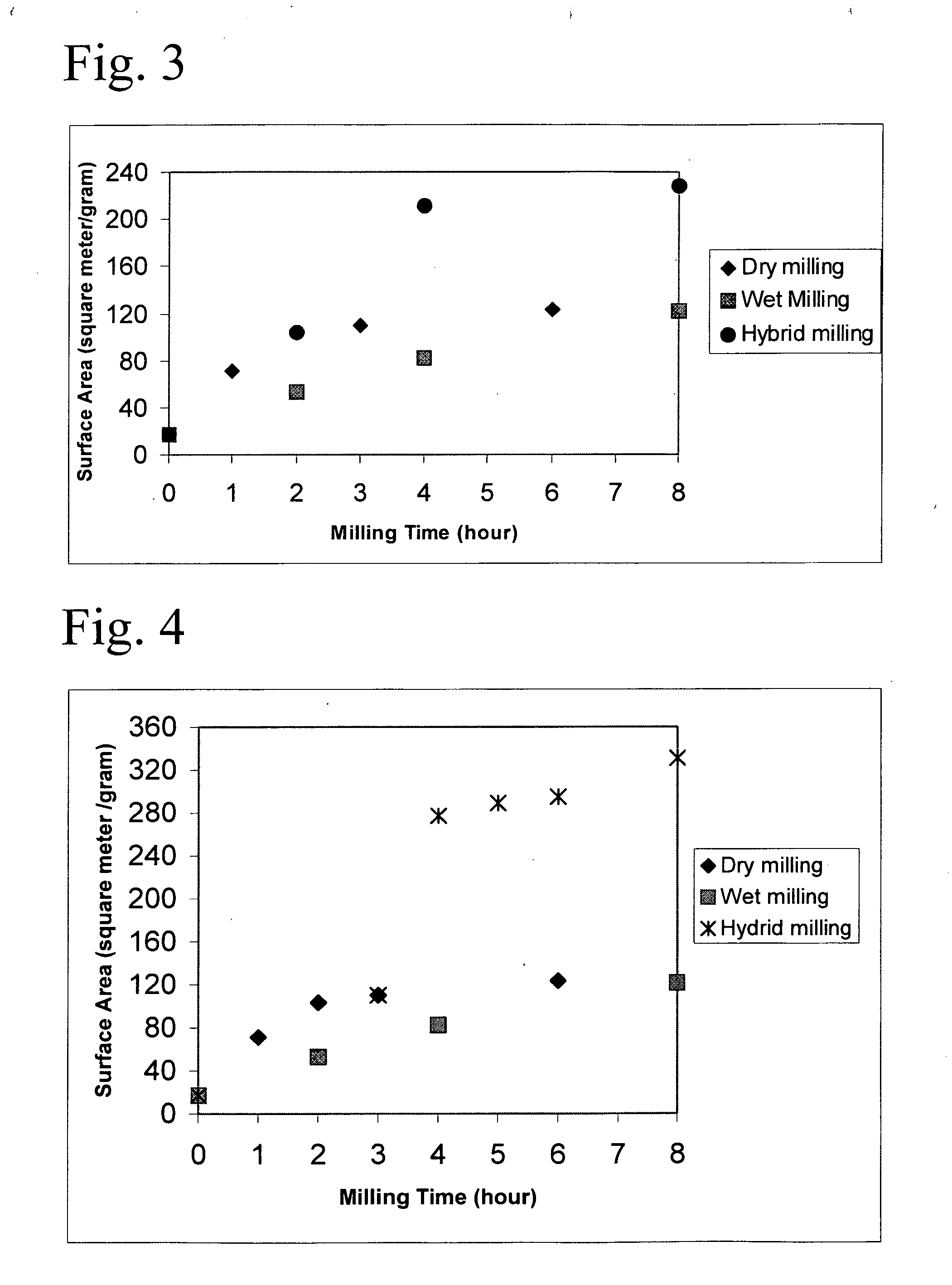Organic solvent dispersed nano-talc slurry
a technology of organic solvent and nano-talc, which is applied in the field of organic solvent dispersed nano-talc slurry, can solve the problems of large number of steps of slurry grinding, inability to reduce the particle size of the majority of particles below 2 microns, and complex equipment and/or additives
- Summary
- Abstract
- Description
- Claims
- Application Information
AI Technical Summary
Problems solved by technology
Method used
Image
Examples
example 1
[0065] This example illustrates the increase in surface area when ground talc is further treated with water in a wet milling process.
[0066] UltraTalc™ 609 talc powder (800 g, Specialty Minerals Inc., initial SSA about 17 m2 / g, 0.9 um average particle size) and 4.8 mm yttria-stabilized zirconia balls (16 Kg, d=5.75 g / cm3) were loaded into an Union Process 1-S Attritor with stainless steel tank and shaft and mechanically milled (energy input about 0.8 KW / h) with external water cooling for 3 hours at 350 rpm to provide a powder with an SSA of 113.8 m2 / g). Untreated tap water (2.5 L) was added to the tank and milling continued for another 3 hours. The slurry was discharged and dried in an oven (100° C., 12 h, in air). The resulting powder has an SSA of 295.1 m2 / g. The particle size is an average platelet diameter of about 80 to 100 nm as determined by TEM on a sample dispersed in methanol and deposited on a carbon grid.
[0067] A 20 cm deep sample of the talc slurry separated into about...
example 2
[0068] This example illustrates the increase in surface area when ground talc is soaked in water for a period of time.
[0069] UltraTalc™ 609 talc powder (800 g Specialty Minerals Inc., initial SSA about 17 m2 / g, 0.9 urn average particle size) and 4.8 mm-yttria stabilized zirconia balls (16 Kg) were loaded into an Union Process 1-S Attritor with stainless steel tank and shaft and mechanically milled for 3 hours at 350 rpm. During milling, the tank was cooled by cycling water to room temperature. After discharging, the SSA of the powder was 110.2 m2 / g. The milled powder was mixed with untreated tap water (5 parts by weight), soaked for 16 hours, and then was dried in an oven (100° C., 12 h, in air). The resulting powder had an SSA of 263.5 m2 / gram. The particle size was about 80 to 100 nm as determined by TEM on a sample dispersed in methanol and deposited on a carbon grid.
[0070] A 5 cm deep sample of the talc slurry separated into 3 cm water and 2 cm talc sediment over a period of a...
example 5
[0075] This example describes the hybrid milling process with a 1 hr. milling time providing the results illustrated in FIG. 2.
[0076] Talc was milled for 1 h as described in example 1 providing a powder with an SSA of 71 m2 / g. After adding 2.5 liters of tap water, milling was continued for another 7 hours with a sample taken at 3 hours (SSA 141.5 m2 / g). The slurry was discharged and dried in an oven to provide a powder with a SSA of 180.5 m2 / g and a particle size measured by TEM to be 120˜170 nm.
PUM
| Property | Measurement | Unit |
|---|---|---|
| Diameter | aaaaa | aaaaa |
| Nanoscale particle size | aaaaa | aaaaa |
| Specific surface area | aaaaa | aaaaa |
Abstract
Description
Claims
Application Information
 Login to View More
Login to View More - R&D
- Intellectual Property
- Life Sciences
- Materials
- Tech Scout
- Unparalleled Data Quality
- Higher Quality Content
- 60% Fewer Hallucinations
Browse by: Latest US Patents, China's latest patents, Technical Efficacy Thesaurus, Application Domain, Technology Topic, Popular Technical Reports.
© 2025 PatSnap. All rights reserved.Legal|Privacy policy|Modern Slavery Act Transparency Statement|Sitemap|About US| Contact US: help@patsnap.com



